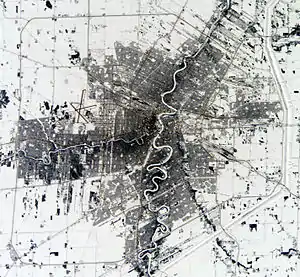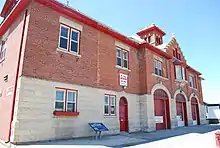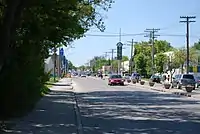St. Vital, Winnipeg
St. Vital (French: Saint-Vital) is a district of the city of Winnipeg, Manitoba, Canada. Located in the south-central part of the city, it is bounded on the north by Carrière Avenue, on the south by the northern limit of the Rural Municipality of Ritchot, on the west by the Red River and on the east by the Seine River, except for the part lying south of the Perimeter Highway, which extends east across the Seine to the boundary of the Rural Municipality of Springfield. The population as of the 2016 census was 67,580.[1]
St. Vital | |
|---|---|
Suburb | |
 St. Vital | |
| Coordinates: 49°51′47″N 97°06′35″W | |
| Country | |
| Province | |
| City | Winnipeg |
| Settled | 1822 |
| Established | 1880 |
| Incorporated as a City | 1962 |
| Government | |
| • MP | Dan Vandal |
| • Councillor | Brian Mayes |
| Area | |
| • Suburb | 63.3 km2 (24.4 sq mi) |
| • Metro | 5,306.79 km2 (2,048.96 sq mi) |
| Population (2016)[1] | |
| • Suburb | 67,580 |
| • Density | 1,100/km2 (2,800/sq mi) |
| • Metro | 778,489 |
| Time zone | UTC-6 (CST) |
| • Summer (DST) | UTC-5 (CDT) |
| Forward Sortation Areas | R2M, R2N |
| Area code(s) | Area codes 204 and 431 |
St. Vital is a city ward, represented by a member of Winnipeg City Council. With slightly different boundaries, it also comprises the Winnipeg neighbourhood clusters of St. Vital North and St. Vital South.
History

The community was established by francophone settlers in 1822, and is the second-oldest permanent settlement in Manitoba after Kildonan.[2] It was named St. Vital by Archbishop Taché in 1860, in honour of the patron saint of his colleague, Father Vital-Justin Grandin.[3]
The original Parish of St. Vital consisted in present-day St. Vital in addition to much of Fort Garry, another present-day suburb on the west side of the Red River. The parish was home to many French-speaking settlers, particularly Métis, a heritage reflected in the names of many of its institutions and streets.
St. Vital remained a strongly francophone community in the early decades after Manitoba's incorporation as a Canadian province in 1870. Until 1910, every reeve and every councillor was of a francophone background. The anglophone population grew throughout this period, however, and Richard Wilson was elected as St. Vital's first anglophone reeve in 1912. Council business was conducted in English after 1913. The municipal government became more pro-business after this period, and supported municipal expansion: St. Vital's population increased from only 1,800 at the end of World War I to 11,000 in 1933. By 1951, 63% of St. Vital's population was of British background, and the francophone population had fallen to under 13%.[4] As of 2006, 17.4% of residents of St. Vital speak either both English and French or French only, while 82% speak English only and 0.6% speak neither English nor French.[5]
In 1923 St. Vital adopted the single transferable voting system for its municipal elections. This system was in use until St. Vital merged with the City of Winnipeg in 1972, whereupon it moved to first-past-the-post voting.[6]
In 1926 the municipality faced bankruptcy, as municipal growth outstripped tax revenues. Control of the municipality was assumed by the provincial Municipal and Public Utilities Board for one year.[7]
From 1920 to 1958, St. Vital was part of the provincial electoral division of St. Boniface.[8]
St. Vital became involved in a school controversy in 1963–64, when six francophone families took their children out of school to protest bus fees for parochial school students. The matter was resolved following a three-month standoff.[9]
The district was seriously affected by the 1950 Red River flood; at one point, the entire developed area of St. Vital was under water.[10] The neighbourhoods of Kingston Crescent and Elm Park were the hardest hit.[11] The fire hall in Elm Park was protected with sandbags and sheltered dozens of evacuees, as shown in a photo published in the May 1, 1950 edition of Life magazine.[12]
St. Vital was a separate municipality until 1971. It originally held the status of a rural municipality, and was then incorporated as a town and then eventually a city. Some residents were reluctant to amalgamate with Winnipeg in 1971, and the former municipal government held a mock burial of the city crest.[7][13]
Demographics
| Year | Pop. | ±% |
|---|---|---|
| 1971 | 32,500 | — |
| 1976 | 39,365 | +21.1% |
| 1981 | 43,620 | +10.8% |
| 1986 | 51,030 | +17.0% |
| 1991 | 57,395 | +12.5% |
| 1996 | 59,540 | +3.7% |
| 2001 | 59,840 | +0.5% |
| 2006 | 61,605 | +2.9% |
| 2011 | 65,330 | +6.0% |
| 2016 | 67,580[14] | +3.4% |
Facilities

With the exception of a significant (though diminishing) semi-rural district in the south, St. Vital is almost entirely residential and has never been home to significant industrial or commercial enterprises, other than retail shops.
Its attractions include the St. Vital Centre, a major regional shopping centre that opened in October 1979, the Riel House National Historic Site (consisting in the home of the family of Métis leader Louis Riel, restored to its 1886 condition), and St. Vital Park, one of Winnipeg's largest city parks. Maple Grove Park is similar in size to St. Vital Park but more recently established. A system of linear parks along the Seine River is under development on the east side of the suburb. Guay Park in north St. Vital contains a war memorial erected in honour of St. Vital residents killed in the two World Wars and in Korea.
St. Vital Outdoor Pool was opened in 1967 as a Centennial project,[15] and was renovated in the June 30, 2016.[16] Upon reopening there, due to increased demand beyond allowable capacity,several swimmers were turned away.[17]
Neighbourhoods
St. Vital includes many working-class and middle-class neighbourhoods. Among them are Elm Park, Varennes, Pulberry, Glenwood, Norberry, Minnetonka (also known as Riel), River Park South, Meadowood Park and Normand Park.
Major streets in St. Vital include St. Mary's Road, St. Anne's Road, Bishop Grandin Boulevard, Fermor Avenue (part of the Trans-Canada Highway), Nova Vista, Warde Avenue, Beliveau Road, Meadowood Avenue, and Dunkirk Drive (and its southerly extension, Dakota Street).
Sports
The St. Vital area contains a number of community centres, including the St. Vital Centennial Arena and the Jonathan Toews Community Centre (formerly the Dakota Community Centre). The St. Vital Victorias are members of the Manitoba Major Junior Hockey League, while the Winnipeg Saints played in the Manitoba Junior Hockey League from 2000–2012.[18] Maple Grove Park is home to the St. Vital Mustangs Football Club and Manitoba's largest rugby complex.
| Team | Founded | League | Arena | Championships |
|---|---|---|---|---|
| St. Vital Victorias | 1975 | MMJHL | St. Vital Centennial Arena | 1 |
Education
Most public schools are operated by the Louis Riel School Division; the exceptions are two schools for francophones in south St. Vital operated by the Division Scolaire Franco-Manitobaine.[19] There are also two parochial schools administered by the Roman Catholic Archdiocese of Saint Boniface, and a number of private schools.[20]
Health care
The only major health care facility in St. Vital is St. Amant, located on River Road in the Minnetonka neighbourhood. It was originally a tuberculosis hospital, but was repurposed as a facility for developmentally challenged children in 1959. In 1974 it was renamed to honour Beatrice St. Amant.[21] The neighbouring suburb of Fort Richmond is home to the Victoria General Hospital and nearby St. Boniface is home to the province's second largest hospital, St. Boniface General Hospital (Winnipeg).[22]
Notable residents
- Janet Arnott, curling coach and Olympic gold medallist[23]
- Reid Carruthers, World Curling Champion[24]
- Nigel Dawes, NHL player[25]
- Danny Duggan, professional wrestler
- Monica Goermann, gymnast[26]
- Jennifer Jones, curler and 2014 Olympic gold medallist[27]
- Brad Katona, UFC fighter[28]
- Pete Kelly, NHL player
- Scott Koskie, professional volleyball player
- Connie Laliberte, curler
- Vic Lindquist, professional hockey player
- Gabby May, gymnast
- Corrine Peters, curler
- Andrea Slobodian, reporter[29]
- Sami Jo Small, professional hockey player[30]
- Adam Smoluk, actor and director[31]
- Yolande Teillet, professional baseball player[32]
- Jonathan Toews, Captain of the Chicago Blackhawks, MVP and 3x Stanley Cup champion[33]
References
- "2016 Census Data - St. Vital Community Area" (PDF). City of Winnipeg. July 24, 2019. Retrieved August 24, 2019.
- Ian Stewart, Just One Vote: Jim Walding's nomination to constitutional defeat, (Winnipeg: University of Manitoba Press), 2009, p. 18.
- William J. Fraser, "Bishop Grandin Remembered", Manitoba History Society, accessed 14 September 2009.
- Stewart, pp. 19–21.
- 2006 Census returns - St. Vital. Accessed October 21, 2009.
- Bowler and Grofman, Elections in Australia...(2000), p. 208, 233)
- History of St. Vital Fire Hall. Archived 2010-01-08 at the Wayback Machine Accessed October 8, 2009.
- Stewart, p. 21.
- Stewart, p. 20.
- Flood Scenes from 1950 from the City of Winnipeg. The first image is of a completely inundated St. Vital. Accessed 1 August 2009.
- Review of Historic Flood Data from the Red River Floodway Authority. Accessed 1 August 2009.
- "Refugees and pets crowding St. Vital Fire Hall". Life Magazine, May 1, 1950. Accessed August 1, 2009.
- Pihichyn, Paul (December 31, 1971). "Louis Riel's Home Stands In St. Vital". Winnipeg Free Press. p. 19.
- "2016 Census Data St. Vital Community Area 2016" (PDF). City of Winnipeg.
- "Council has pool problem". Winnipeg Free Press. June 20, 1967. p. 3.
- "St. Vital outdoor pool reopens". Winnipeg Free Press - The Lance. July 11, 2016.
- Santin, Aldo (December 3, 2016). "City pool lifeguard tells it like it is". Winnipeg Free Press. p. B1.
- "City renames community centre after Jonathan Toews". Winnipeg Free Press. 2010-07-11.
- Division Scolaire Franco-Manitobaine schools map. In French. Accessed October 8, 2009.
- Catholic Schools Commission. Archived 2010-01-15 at the Wayback Machine Archdiocese of St. Boniface. Accessed October 8, 2009.
- Biography of Beatrice St. Amant from the Province of Manitoba. Accessed October 8, 2009.
- History of St. Amant Centre. Accessed October 8, 2009.
- "JANET ELIZABETH ARNOTT". Winnipeg Free Press. 24 June 2019. Retrieved 8 January 2021.
- "Busy summer ahead for Reid Carruthers". Winnipeg Sun. 13 May 2016. Retrieved 8 January 2021.
- "Russian bear: Winnipegger mauling KHL". Winnipeg Sun. 21 December 2018. Retrieved 8 January 2021.
- "Retired Women: Monica Goermann". Gym.ca. Retrieved 8 January 2021.
- "Team Jones gets honourary street name in St. Vital". CBC News. 18 September 2014. Retrieved 8 January 2021.
- "The Ultimate Fighter champ Brad Katona of Winnipeg reaching for the stars". Global News. 11 July 2018. Retrieved 8 January 2021.
- "Andrea Slobodian". Global News. 3 September 2008. Retrieved 8 January 2021.
- "FIVE-TIME WORLD CHAMPION SAMI JO SMALL". St. Vital Museum. Retrieved 8 January 2021.
- "Film Training Manitoba celebrating two decades". Winnipeg Free Press. 28 January 2020. Retrieved 8 January 2021.
- "Memorable Manitobans: Yolande Teillet Schick (1927-2006)". Manitoba Historical Society. Retrieved 8 January 2021.
- "Jonathan Toews gives $1M to Dakota Community Centre". CBC news. 7 December 2016. Retrieved 8 January 2021.
Further reading
- St. Vital, Man. (1951). "Town planning scheme for the rural municipality of St. Vital".